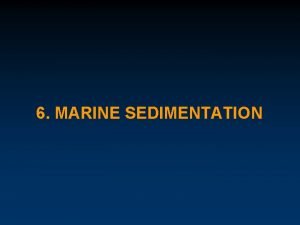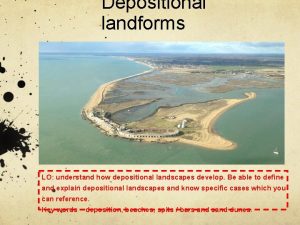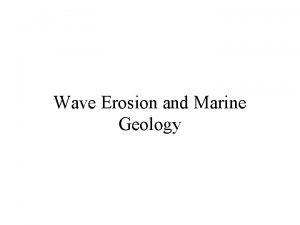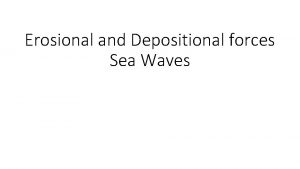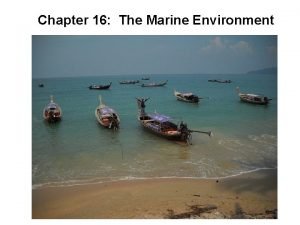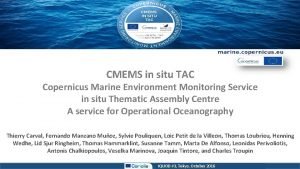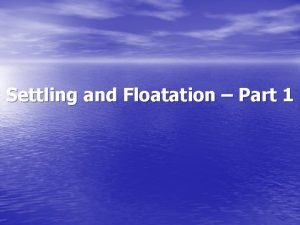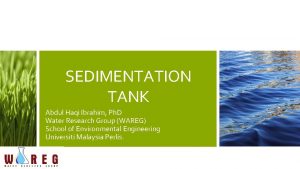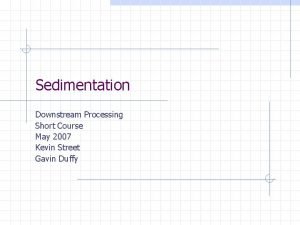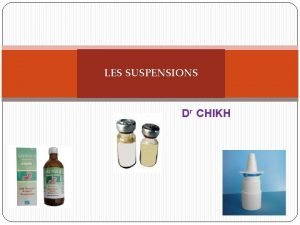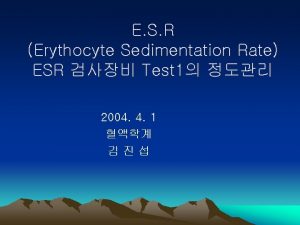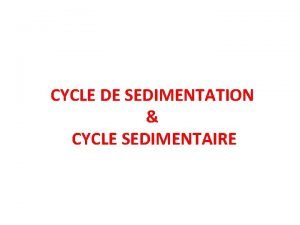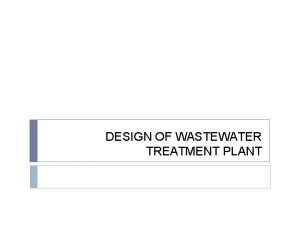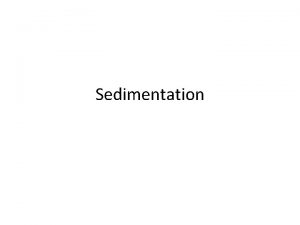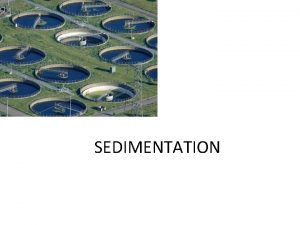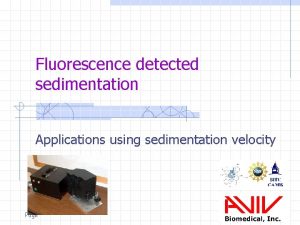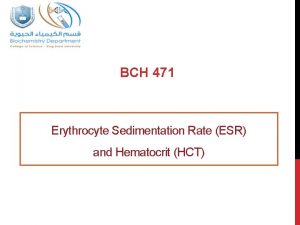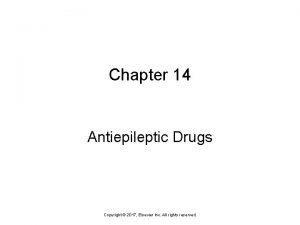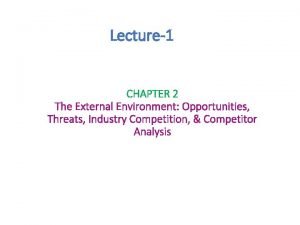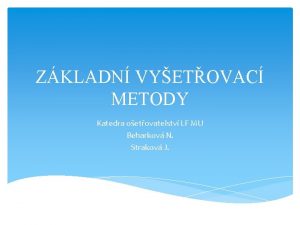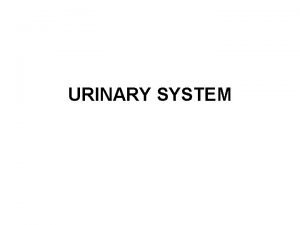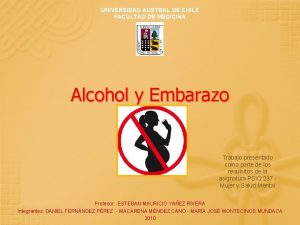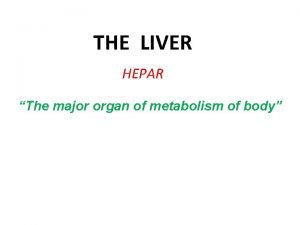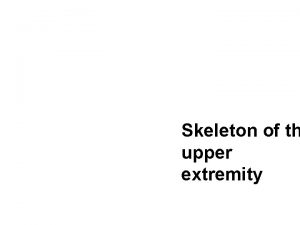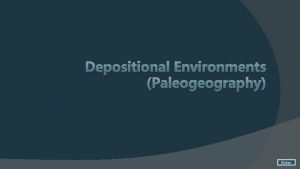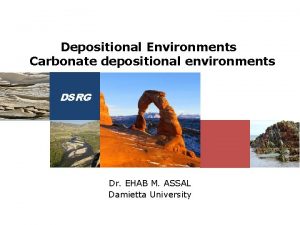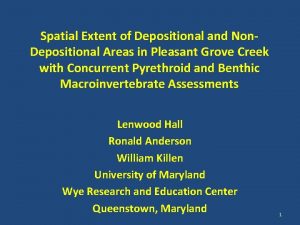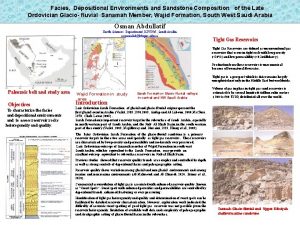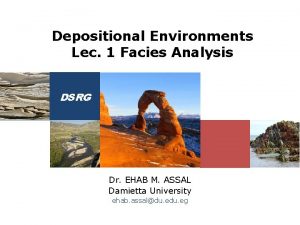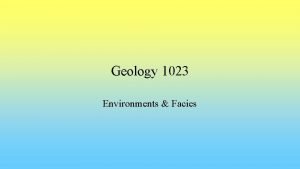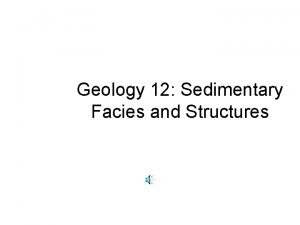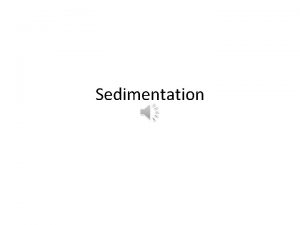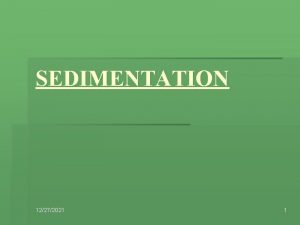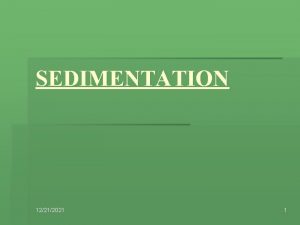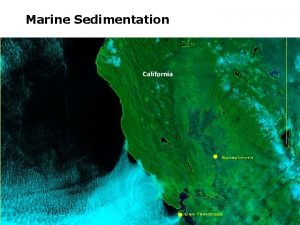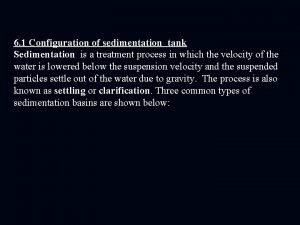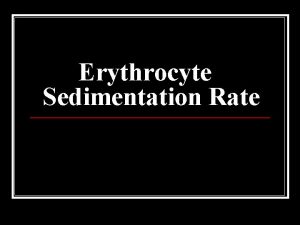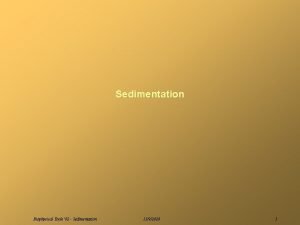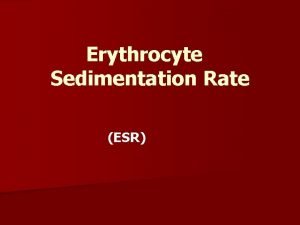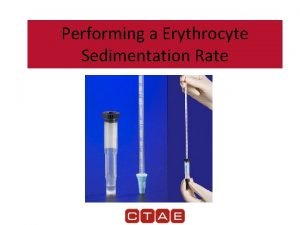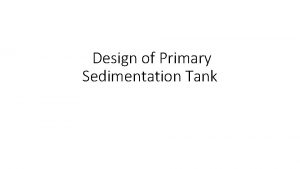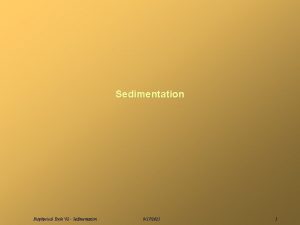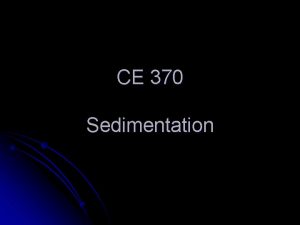6 MARINE SEDIMENTATION FACIES DEPOSITIONAL ENVIRONMENT Definition Physical










































- Slides: 42

6. MARINE SEDIMENTATION

FACIES & DEPOSITIONAL ENVIRONMENT Definition Physical Marine Process • Wave • Tidal Current • Wave Associated Current • Ocean Current Systems • Tides • Storms as Geological Agents • Hurricanes and Tropical Storms • Tsunamis Marine Facies & Depositional Environment • Coastal Environment & Facies Model • Barrier Environment & Facies Model • Beach Environment & Facies Model • Continental Margine Environment & Facies Model • Deep Marine Environment & Facies Model Marine Sedimentary Characteristic

FACIES & DEPOSITIONAL ENVIRONMENT Reef / Bioclastic Limestone al r Lito Shore eri Sea Leve l UD P IS Su b. A Distributary Channel al line Mouth Bar SH D / MI D UP SA : Sub Aerial UDP : Upper Delta Plain LDP : Lower Delta Plain UDF / Lit : Upper Delta Front LP UD F D LD F EL F LD P LEGENDA LDF / IS : Lower Delta Front / Litoral UPD /IS : Upper Prodelta / Inner Shelf LPD /MS : Lower Prodelta / MId Shelf CS / R : Carbonate Shelf / Reef

Physical Marine Process WAVE PROCESS Wave shoaling and breaking. As deep-water waves are transformed by interaction with the bottom, the wave length is reduced and height increased until they reach a maximum peak. The wave then collapse in the form of breakers, whih are classed as surging, spiling or plunging

Physical Marine Process Wave Associated Current

TIDES Worldwide distribution of coastal tidal ranges Davis 1964 classified the world's shorelines as either microtidal (tidal range = 0 -2 m); mesotidal (tidal range = 2 -4 m) or macrotidal (tidal range greater than 4 m).

Physical Marine Process Ocean Current Systems Major ocean current and climate zones

Physical Marine Process Hurricanes and Tropical Storms Westward moving tropical waves are best known for the "low" part of the surface pressure cycle. Tropical lows generally exhibit variable weaker winds and increased cloudiness and precipitation. Wave conditions under a tropical low are usually calmer on the average, except near centers of strong precipitation, which are accompanied by strong winds (and large seas) of short duration. Coastal erosion from Hurricane surge and waves

Physical Marine Process Tsunamis are much less frequent than hurricanes, but the size and power of the wave forces is devastating (Wave Spectra). Faulting (earthquakes), massive submarine slope failure and volcanic activity can generate a tsunami that can propogate over an entire ocean basin. These are essentially high speed tidal waves that are modified in deep water because of the extreme wave length. The high wave crest breaking and falling onshore can create major damage and modify sediment patterns. Spectrum of wave energy in the ocean

MARINE DEPOSITIONAL ENVIRONMENT & FACIES MODEL BARRIER ENVIRONMENT The major sedimentary environments of a barrier island consists of: • The mainland, • Backbarrier lagoon, • Barrier island, • Inlets and inlet deltas, • Barrier platform, and • The shoreface

MARINE DEPOSITIONAL ENVIRONMENT & FACIES MODEL COASTAL ENVIRONMENT

MARINE DEPOSITIONAL ENVIRONMENT & FACIES MODEL BARRIER FACIES MODEL Three “end-member” facies successions associated with regressive and transgressive barrier island, and inlet migration. After Reinson (1984)

MARINE DEPOSITIONAL ENVIRONMENT & FACIES MODEL LAGOON FACIES MODEL Generalized lagoonal sequence through back barrier deposits in the Carboniferous of eastern Kentucky and southern West Virginia. Such sequences range from 7. 5 to 24 m thick. From Horne and ferm (1978)

MARINE DEPOSITIONAL ENVIRONMENT & FACIES MODEL Tidal Channel FACIES MODEL Tidal channel-fill sequences for an inlet channel located along an active barrier-island. After Moslow an Tye (1985)

MARINE DEPOSITIONAL ENVIRONMENT & FACIES MODEL BEACH ENVIRONMENT The beach has three major parts: beach face, berm and backbeach The beach consist of a shorface, nearshore zone, and dune associated with a beach. Not all of these element are present in many beaches.

SHORELINE-SHALLOW MARINE PROFILE VERTICAL SCALE GREATLY EXAGGERATED WAVES BEGIN TO BUILD UP SPILLING BREAKERS SHOALING WAVES L HIGH TIDE SURF ZONE 5 – 15 M LOW L 2 LONGSHORE BARS FORESHORE FAIRWEATHER WAVE BASE LOWER MIDDLE UPPER SHOREFACE STORM WAVE BASE OFFSHORE MUDDY SUBSTRATE SANDY SUBSTRATE Skolithos Cruziana Zoophycos Ichnofacies

RUNNEL SYSTEM IN THE BEACH ENVIRONMENT

MARINE DEPOSITIONAL ENVIRONMENT & FACIES MODEL BEACH FACIES MODEL

MARINE DEPOSITIONAL ENVIRONMENT & FACIES MODEL BEACH ENVIRONMENT Consists Of: continental rise continental slope continental shelf Generalized cross section of continental margin shows deep basin, buried beneath the shelf and slope, which is filled with sediments. A buried reef mark an old shelf edge.

MARINE DEPOSITIONAL ENVIRONMENT & FACIES MODEL CONTINENTAL SHELF FACIES MODEL Vertical sequences produced through transgression of different types of coastal environments. Modified from Demarest and Kraft (1987)

MARINE DEPOSITIONAL ENVIRONMENT & FACIES MODEL Submarine canyons are common along the continental slope. They are ubiquitous on both active and passive margins. Some extend landward across the continental shelf. They typically cut through the edge of the continental shelf and terminate on the deep abyssal floor, some 5, 000 or more feet below sea level. DEEP MARINE ENVIRONMENT Turbidity currents intermittently flush sediments through the canyons building up depositional fans where the currents reach the lower gradient of the ocean floor. The abyssal plain is the deep ocean floor. It is basically flat, and is covered by very finegrained sediment, consisting primarily of clay and the shells of microscopic organisms (such as foraminifera, radiolarians, and diatoms). Generalized three-dimension is showing submarine canyon and deep sea environment

MARINE DEPOSITIONAL ENVIRONMENT & FACIES MODEL DEEP MARINE ENVIRONMENT Stratigraphic section of deep marine facies, showing basin floor, channels and levee deposits.

MARINE SEDIMENTARY ENVIRONMENT REEF CONTINENTAL SHELF CONTINENTAL SLOPE AND RISE ABYSSAL PLAIN Fossiliferous limestone Sandstone, shale, siltstone, fossiliferous limestone, oolitic limestone Litharenite, siltstone, and shale (or limestone) Shale, chert, micrite, chalk, diatomite Carbonate Terrigenous or carbonate Gray to white Gray to brown Gray, green, brown Black, white red Variable, frameworks, few to no grains Clay to sand Clay Grain Shape --- --- Sorting --- Poor to good Poor Good Lamination Rock Type Composition Color Grain Size Inorganic Sedimentary Structures --- Lamination, crossbedding Graded bedding, crossbedding, lamination, flute marks, tool marks (turbidites) Organic or Biogenic Sedimentary Structures --- Trails, burrows Corals, marine shells Marine shells, rare plant fragments Marine shells (mostly microscopic) Fossils

SEA WATER COMPOSITION

TRANSITIONAL SEDIMENTARY ENVIRONMENT BARRIER BEACH LAGOON TIDAL FLAT Quartz arenite, coquina Siltstone, shale, limestone, oolitic limestone or gypsum Siltstone, shale, calcilutite, dolostone or gypsum Terrigenous or carbonate Terrigenous, carbonate, or evaporite Terrigenous, carbonate, or evaporite White to tan Dark gray to black Gray, brown, tan Sand Clay to silt Rounded to angular --- Good Poor Variable Inorganic Sedimentary Structures Cross-bedding, symmetrical ripples Lamination, ripples, cross-bedding Lamination, mudcracks, ripples, cross-bedding Organic or Biogenic Sedimentary Structures Tracks, trails, burrows Trails, burrows Stromatolites, trails, tracks, burrows Marine shells Rock Type Composition Color Grain Size Grain Shape Sorting Fossils

MINERAL OF MARINE DEPOSIT FUNDAMENTAL DEFINITIONS A "mineral occurrence" is a concentration of a mineral (usually, but not necessarily, considered in terms of some commodity, such as copper, barite or gold) that is considered valuable by someone somewhere, or that is of scientific or technical interest. In rare instances (such as titanium in a rutile-bearing black sand), the commodity might not even be concentrated above its average crustal abundance. A "mineral deposit" is a mineral occurrence of sufficient size and grade that it might, under the most favorable of circumstances, be considered to have economic potential.

SAMPLE OF MARINE DEPOSIT MINERALS Glauconite (K, Na)(Al, Fe 3+, Mg)2(Al, Si)4 O 10(OH)2 System. Monoclinic. Appearance. Very tiny crystals. Usually in spherulitic, earthy aggregates, sometimes platy, light blue-green Physical properties. Soft (2 -2. 5), light, perfect basal cleavage. Transculent with rather greasy luster. Environment. A mineral of marine origin, found in sedimentary deposits of various kinds (sands, sandstones, silts, impure limestones), probably as a diagenetic mineral.

SAMPLE OF MARINE DEPOSIT MINERALS Sulfur - S System. Orthorhombic. Appearance. Frequently in fine, dipyramidal crystals, granular aggregates, impregnations and incrustations. Color varies from the characteristic lemon-yellow, when the mineral is pure, to brown and black. Physical properties. Very soft to soft (1. 5 -2. 5), very light, fragile, with poor cleavage. Transparent to translucent with resinous to greasy luster. Environment. A mineral associated with sedimentary deposits of the evaporite type and with oil-bearing deposits. Believed to be a product of the dissociation of sulfates (especially gypsum) caused by the action of certain bacteria.

Siderite – Fe. CO 3 System. Hexagonal. Appearance. Rhombohedral crystals with curved, striated faces. Sometimes with tabular habit and in saddle-shaped aggregates. Botryoidal, compact, oolitic, concretionary masses common, varying in color from pale yellow to dark brown or almost black when a large amount of manganese is present. Physical properties. Semi-hard (3. 5 -4), heavy, fragile, perfect rhombohedral cleavage. Transparent or translucent with bright vitreous luster. White streak. Alters readily on the surface, becoming coated by brown goethite. Practically infusible. Decomposes at a moderate temperature, turning brown and becoming magnetic. Environment. Formed in environment of continental waters with low oxygen content, associated with clay and carbonaceous material. SAMPLE OF MARINE DEPOSIT MINERALS

SAMPLE OF MARINE DEPOSIT MINERALS Pyrite - Fe. S 2 System. Isometric Appearance. Striated, cubic, octahedral or pyritohedral crystals, sometimes occuring as “iron cross” twins. Compact, granular aggregates. Concretions, mammilated and stalactitic nodules. Always fairly dark yellow, sometimes with an iridescent yellowish-brown film. Physical properties. Hard (6 -6. 5), very heavy, very fragile, with poor cleavage. Opaque with very bright metallic luster. Greenish-black streak. Environment. Pyritized concretionsformed by chemical deposition under the water.

SAMPLE OF MARINE DEPOSIT MINERALS Halite – Na. Cl System. Isometric. Appearance. Cubic crystals, sometimes distorted with cavernous faces, “hopper” crystals. Colorless to white, yellow, red, brown, and even black. Physical properties. Soft (2. 5), very light, fragile with perfect cubic cleavage. Transparent to translucent with vitreous luster. White streak. Environment. As a precipitate in sedimentary deposit caused by the evaporation of saline water. Often interbedded with clay.

Fluorite - Ca. F 2 System. Isometric. Appearance. Cubes, octahedrons, and dodecahedrons, other forms rarer. May be large. Penetration twins sometimes occur. Color extremely variable (allochromatic), colorless and completely transparent when pure, but may be yellow, green, blue, pink, purple, or even black. Campact, banded and concretionary masses are frequently found. Physical properties. Semi hard (4), heavy, fragile, perfect octahedral cleavage. Transparent to translucent with vitreous luster. Environment. In sedimentary origin probably by deposition in enclosed basins from saline waters possibly of volcanic origin. SAMPLE OF MARINE DEPOSIT MINERALS

SAMPLE OF MARINE DEPOSIT MINERALS Magnetite - Fe 2+Fe 3+2 O 4 System. Isometric Appearance. Black, shiny, perfect octahedrons or dodecahedrons with striated faces. Iron-black, campact and granular masses with bluish iridecence. Physical properties. Hard (5. 5 -6. 5), very heavy, no cleavage, but exhibits octahedral parting. Opaque with metallic luster. Black streak. Strongly magnetic and sometimes act as a natural magnet (Iodostone). Environment. Large masses found in sedimentary rocks (alluvial and marine sands).

Hematite - Fe 2 O 3 System. Hexagonal. Appearance. Stubby, black, rhombohedral crystals, often with individual crystal arranged like the petals of rose. More commonly in massive, granular masses, compact, sometimens with iridescence surface, soft and earthy. Often oolitic, botryoidal or concretionary in appearance. Often colors both rocks and minerals shade of red and reddish brown. Physical properties. Hard (5. 5 -6. 5), very heavy, fragile, no cleavage. Opaque with metallic luster, blood red tints in thin section. Streak dark-cherry red. Environment. Formed under sedimentray conditions through diagenesis of “limonite” retaining its concretionary and oolitic foems. SAMPLE OF MARINE DEPOSIT MINERALS

Ilmenite - Fe. Ti. O 3 System. Hexagonal. Appearance. Very flat, taabular, black or dark brown, rhombohedral crystals. Also in compact or granular aggregates. Physical properties. Hard (5 -6), heavy, no cleavage, but fairly good pseudo-rhombohedral fracture. Opaque, even in thin section, with sub metallic luster. Black to brownish red streak. Environment. Large concentration found in marine sand. SAMPLE OF MARINE DEPOSIT MINERALS

Limonite Appearance. Generally occurs as botyoidal, stalactitic, oolitic, or pisolitic, colloform, earthy or porous masses, or in the form of a crust, yellowish broen when loose, blackish and iridencence when more coherent. Physical properties. Very varied, depending on the constituent or the type of aggregations. Frequently semi hard (5 -5. 5), and fragile, disintegrates easily. Transcullent with semi opaque with vitreous to earthy luster. Palebrown streak. Environment. Form in the littoral zones of marine basins as a result of the flocculation of iron hydroxides caused by electrolytic or bacterial action SAMPLE OF MARINE DEPOSIT MINERALS

SAMPLE OF MARINE DEPOSIT MINERALS Calcite - Ca. CO 3 System. Hexagonal. Appearance. Rhombohedral, scalenohedral or prismatic crystals, often intergrown or twinned. Variable color (colorless, white, pink, green, yellow, etc. ). Occurs in masses, compact, microcrystalline (limestones), saccharoidal (marbles), fibrous (alabasters), concretionary (stalactites and stalagmites), pulverulent, oolitic, etc. Physical properties. Semi hard (3), light, with perfect rhombohedral cleavage. Transparet with vitreous or iridescent pearly luster depending on direction, transculent or opaque. White streak Environment. Typical sedimentary mineral formed by chemical precipitation through the evaporation of solutions rich in calcium bicarbonate or by extraction through the action of marine organisms

Dolomite - Ca. Mg(CO 3)2 System. Hexagonal. Appearance. Usually in colorless, white, pink, or yellowish rhombohedral crystals. Aggregates of crystals with curved “saddle” faces frequent. Compact, saccharoidal, sometimes dolomite masses. Physical properties. Semi-hard (3. 54), not very heavy, fragile, perfect rhombohedral cleavage. Transparent or translucent with vitreous or sometimes pearly luster. White streak. Environment. Basic constituent of sedimentary carbonate rocks formed under diagenetic conditions by the action of sea water on calcareous mud or by organogenetic formation SAMPLE OF MARINE DEPOSIT MINERALS

Aragonite - Ca. CO 3 System. Orthorombic. Appearance. Small, elongated, prismatic crystals. Concretionary, pisolitic, stalactitic, fibrous and radiating, or corraloid masses. Colorless, white, yellow, reddish, and various other colors. Physical properties. Semi-hard (3. 54), heavy, fragile, indistinct prismatic cleavage. Transparent or translucent with vitreous luster. White streak. Environment. Formed easily in sedimentary environmet, under metastable conditions, helped by biological action SAMPLE OF MARINE DEPOSIT MINERALS

Gypsum - Ca. SO 4. 2 H 2 O System. Monoclinic. Appearance. Clear, tabular crystals often in swallowtail or spearhead twins. Transparent crystals and cleavage fragments. Fibrous aggregates of elongated satiny crystals. Granular and compact, waxy-looking masses, sometimes banded. White, gray, yellowish or brown. Physical properties. Soft (2) and light. Perfect cleavage into slightly flexible but inelastic plates and very find flakes. Transparent, with vitreous or silky luster, often pearly on cleavage faces. Environment. A typical sedimentary evaporite minerals, formed through direct precipitation from saline waters or through alteration of anhydrite SAMPLE OF MARINE DEPOSIT MINERALS

Biotite - K(Mg. Fe)3(Al, Fe)Si 3 O 10(OH, F)2 System. Monoclinic. Appearance. Rarely in tabular pseudo-hexagonal crystals, black, brown or dark green. Commonly in small disseminated plates or platy aggregates. Physical properties. Soft (2. 5 -3), heavy, perfect basal cleavage into small, flexible, elastic, transparent or translucent, brownish sheets, with very pronounced vitreous luster. Environment. Widespread as a sedimentary mineral in sandstones SAMPLE OF MARINE DEPOSIT MINERALS

Quartz - α-Si. O 2 System. Hexagonal. Appearance. May occur in wellformed crystal, compact oand concretionary masses, microcrystalline to cryptocrystalline. Colorless when pure. Physical properties. Very hard (7), and light. No cleavage, but good conchoidal fracture. Transparent with translucent with vitreous luster. Environment. Stable in sedimentary conditions either as a detrital mineral or as a cement in consolidated rocks (sandstones) SAMPLE OF MARINE DEPOSIT MINERALS
 Definition sedimentation
Definition sedimentation Facies etilica
Facies etilica Depositional landscape
Depositional landscape Weathering
Weathering Erosional vs depositional
Erosional vs depositional Erosional work of sea waves
Erosional work of sea waves Chapter 16 the marine environment
Chapter 16 the marine environment Cmems copernicus
Cmems copernicus Size separation pharmaceutics
Size separation pharmaceutics Examples of floating and settling
Examples of floating and settling Sedimentation
Sedimentation Sedimentation in downstream processing
Sedimentation in downstream processing Corrected esr
Corrected esr Acid ether sedimentation technique
Acid ether sedimentation technique Loi de stokes vitesse de sédimentation
Loi de stokes vitesse de sédimentation Erythocyte sedimentation rate
Erythocyte sedimentation rate Sedimentation technique for stool concentration
Sedimentation technique for stool concentration Schéma cycle sédimentaire
Schéma cycle sédimentaire Sedimentation technique for stool concentration
Sedimentation technique for stool concentration Parasitic ova
Parasitic ova Rectangular clarifier design
Rectangular clarifier design An ideal horizontal flow settling basin
An ideal horizontal flow settling basin Giardia lamblia
Giardia lamblia Application of sedimentation in industries
Application of sedimentation in industries Sedimentation velocity
Sedimentation velocity Normal esr rate
Normal esr rate Financial environment in business environment
Financial environment in business environment Dilantin facies
Dilantin facies Sociocultural segment of the general environment
Sociocultural segment of the general environment Definition of sick child ppt
Definition of sick child ppt What is physical environment
What is physical environment Trauma infromed
Trauma infromed Pricing strategies in marketing
Pricing strategies in marketing Physical fitness components and tests grade 9
Physical fitness components and tests grade 9 Facies febrilis
Facies febrilis L
L Mitral facies
Mitral facies Pars intramuralis
Pars intramuralis Facies vultuos
Facies vultuos Sindrome alcoholico fetal chile
Sindrome alcoholico fetal chile Organ hepar
Organ hepar Hepatic facies
Hepatic facies Facies articularis carpea
Facies articularis carpea
